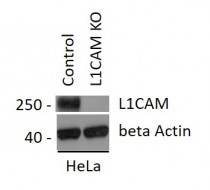ARG59519
anti-L1CAM antibody
anti-L1CAM antibody for ICC/IF,Western blot and Human,Mouse,Rat
Overview
| Product Description | Rabbit Polyclonal antibody recognizes L1CAM |
|---|---|
| Tested Reactivity | Hu, Ms, Rat |
| Tested Application | ICC/IF, WB |
| Host | Rabbit |
| Clonality | Polyclonal |
| Isotype | IgG |
| Target Name | L1CAM |
| Antigen Species | Human |
| Immunogen | Recombinant fusion protein corresponding to aa. 1143-1257 of Human L1CAM (NP_000416.1). |
| Conjugation | Un-conjugated |
| Alternate Names | SPG1; CD171; NCAM-L1; MASA; MIC5; S10; CAML1; HSAS1; N-CAM-L1; CD antigen CD171; N-CAML1; HSAS; Neural cell adhesion molecule L1 |
Application Instructions
| Predict Reactivity Note | Rat | ||||||
|---|---|---|---|---|---|---|---|
| Application Suggestion |
|
||||||
| Application Note | * The dilutions indicate recommended starting dilutions and the optimal dilutions or concentrations should be determined by the scientist. | ||||||
| Positive Control | SH-SY5Y | ||||||
| Observed Size | 200 kDa |
Properties
| Form | Liquid |
|---|---|
| Purification | Affinity purified. |
| Buffer | PBS (pH 7.3), 0.02% Sodium azide and 50% Glycerol. |
| Preservative | 0.02% Sodium azide |
| Stabilizer | 50% Glycerol |
| Storage Instruction | For continuous use, store undiluted antibody at 2-8°C for up to a week. For long-term storage, aliquot and store at -20°C. Storage in frost free freezers is not recommended. Avoid repeated freeze/thaw cycles. Suggest spin the vial prior to opening. The antibody solution should be gently mixed before use. |
| Note | For laboratory research only, not for drug, diagnostic or other use. |
Bioinformation
| Database Links | |
|---|---|
| Gene Symbol | L1CAM |
| Gene Full Name | L1 cell adhesion molecule |
| Background | The protein encoded by this gene is an axonal glycoprotein belonging to the immunoglobulin supergene family. The ectodomain, consisting of several immunoglobulin-like domains and fibronectin-like repeats (type III), is linked via a single transmembrane sequence to a conserved cytoplasmic domain. This cell adhesion molecule plays an important role in nervous system development, including neuronal migration and differentiation. Mutations in the gene cause X-linked neurological syndromes known as CRASH (corpus callosum hypoplasia, retardation, aphasia, spastic paraplegia and hydrocephalus). Alternative splicing of this gene results in multiple transcript variants, some of which include an alternate exon that is considered to be specific to neurons. [provided by RefSeq, May 2013] |
| Function | Cell adhesion molecule with an important role in the development of the nervous system. Involved in neuron-neuron adhesion, neurite fasciculation, outgrowth of neurites, etc. Binds to axonin on neurons. [UniProt] |
| Cellular Localization | Cell membrane; Single-pass type I membrane protein. Cell projection, growth cone. Cell projection, axon. Cell projection, dendrite. Note=Colocalized with SHTN1 in close apposition with actin filaments in filopodia and lamellipodia of axonalne growth cones of hippocampal neurons (By similarity). In neurons, detected predominantly in axons and cell body, weak localization to dendrites (PubMed:20621658). [UniProt] |
| Calculated MW | 140 kDa |
Images (2) Click the Picture to Zoom In
-
ARG59519 anti-L1CAM antibody WB image
Western blot: 25 µg of SH-SY5Y cell lysate stained with ARG59519 anti-L1CAM antibody at 1:1000 dilution.
-
ARG59519 anti-L1CAM antibody WB image
Western blot: 25 µg of extracts from normal (control) and L1CAM knockout (KO) HeLa cells, using ARG59519 anti-L1CAM antibody at 1:1000 dilution.







